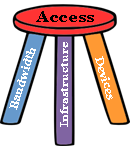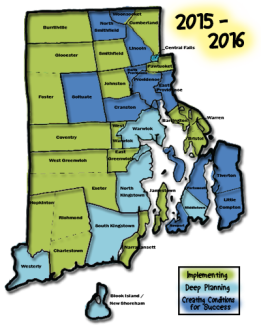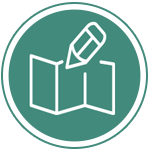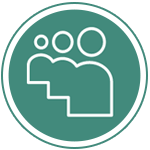Reimagining Technology Access
A robust, reliable technology infrastructure and readily available connected devices and tools are essential for any digital learning transition, and can be challenging to create and maintain in K-12 schools.
Cloud computing, mobile devices, and bring your own device programs are providing new options that are, in many situations, more cost effective.
Access to Technology: A Three Legged Stool

The Rhode Island educational landscape is changing greatly as districts and schools implement college and career-ready standards for all students; utilize online assessments to gauge comprehension and learning; and deal with constrained school budgets. RIDE has several initiatives to help ensure that students and educators have access to the appropriate technology tools to achieve these goals.
Bandwidth - E-Rate/RITEAF Program
The Rhode Island Telecommunications Access Fund (RITEAF) program is a legislative commitment to ensure that Internet Access is available and affordable for all private and public K-12 schools and all public libraries. The RITEAF program supplements the federal E-Rate program.
Infrastructure - Wireless Classroom Initiative Technology Bond
RIDE, alongside a host of those in our educational community, worked hard to include a technology infrastructure investment in the Governor's budget that provides wireless access to the Internet in every classroom. The Wireless Classroom Initiative technology infrastructure bond provided $20 million to expand wireless access to all classrooms across the state.

Devices - Large Scale 1:1 Implementations
ALL Rhode Island schools are diligently working to personalize the student learning experience with individualized approaches to provide every student with opportunities for success. Many districts and schools are leveraging technology and blended learning strategies to achieve their personalization outcomes. The map to the right shows districts that are implementing large scale 1:1 computer initiatives as part of those efforts.
Technology and Infrastructure Resources and Research
The resources in this section provide background information and examples of these approaches, along with recommendations for addressing Internet safety and appropriate or responsible use issues.
- The Education Super Highway’s mission is to ensure that every K-12 public school in America has the 100 Mbps of Internet infrastructure that students and teachers need for digital learning and teaching. This website provides lots of information about why K-12 networks fail and a speed test to assess your schools K-12 internet readiness.
- The Broadband Imperative: Recommendations to Address K-12 Education Infrastructure Needs. State Education Technology Directors Association (SETDA), 2012. Provides an overview of the state of broadband in schools, homes and communities; trends driving the need for more bandwidth in education, and a framework for assessing school bandwidth requirements.
- ERATE Modernization Resources - SETDA and Common Sense Kids Action developed several resources to support state and local policy makers and digital leaders as they navigate the modernized ERATE program.
- Planning for Progress in Digital Learning: Introduction to Technology & Infrastructure (Video)
- Forsyth County Schools, Georgia, BYOT (Bring Your Own Technology) Resources provides example policies, recommendations, videos from schools, and links to articles about how to successfully implement a BYOT initiative. One starting point is a guest blog by Tim Clark, the district CTLO, on The Contraband of Some Schools is the Disruptive Innovation of Others with BYOT.
- Rethinking Acceptable Use Policies to Enable Digital Learning: A Guide for School Districts. Consortium on School Networking (CoSN), March 2013. An up-to-date guide to internal safety and acceptable use laws and policies — now called responsible use policies — with example policies.
- GenYes: Student Powered Technology Integration. Provides and overview and detailed guidelines and resources about a research-based program that involves students in providing school-based technical support and working with teachers to design technology-infused lessons. Provides an example of changing roles for students.
- Common Sense Media - Rates, educates, and advocates for kids, families and schools. Find resources to help with parent concerns, digital citizenship, tools for educators, and more!
- Considering a 1-to-1 program but don't know where to start? 1-to-1 Essentials offers the guidance needed in order to proactively, rather than reactively, address issues that schools commonly face when going 1-to-1. Explore, customize, and choose the resources that will best support your school community. Take a look at the 1-to-1 Essentials Overview.







